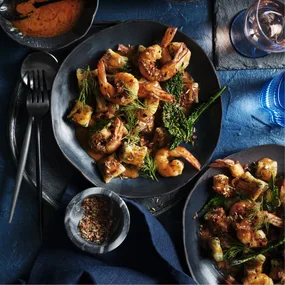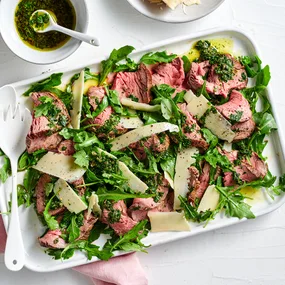In Asterix in Britain, that great French critique of British culture, food-loving Obélix complains about the boiled offerings of meat in, I think, a rather harsh way. Shame on you, Goscinny and Uderzo! Boiled ham and parsley sauce, boiled mutton and caper sauce, and indeed boiled beef and dumplings are all fantastic dishes, as richly deserving of a place in the culinary pantheon as France’s pot-au-feu and Italy’s bollito misto, with which they share a common bond. Historically, we have brined meat out of necessity to preserve it, but it also helps it retain its moisture, and we have come to love the taste.
One of the most useful things my mother taught me in the kitchen was not to boil meat, but just to give it the gentlest of simmers. Imagine if you were dropped into a pot of boiling water. You would tense up, so why would you do this to your meat? Just picture yourself relaxing in a hot bath – we are meat too!
The beef is brisket, the dumplings are little suet clouds poached in the beef broth, as are carrots, leeks and onions. I can still see my dad’s dreamy look at seeing plated-up poached onions. The extras are wonderful: pickled walnuts and horseradish sauce. If you can manage to get a forkful with a bit of beef, a piece of dumpling, a pickled walnut and some horseradish sauce to boot, a magical moment will take place.
The other thing to remember with this dish is its possibilities the next day: you could make a beef sandwich, or simply serve the beef cold and thinly sliced with green sauce or horseradish sauce. Or you could make a hash. Hash is a very good dish if you are feeling a little dented, and is a fine and useful way of using up the remains of pot-roast brisket and boiled beef and dumplings alike. Another very delicious possibility is to fry off potatoes with some of the poached onions (use red onions if none are left over), some of the cold beef and a splash of the broth, simmer gently for a moment, add a huge handful of chopped parsley and serve. The suet clouds fry up nicely the next day, although they may not be quite so cloud-like.
To make your horseradish sauce, finely grate a peeled 13cm stick of horseradish (this can be quite an emotional experience and may bring tears to your eyes, but is very good for clearing the tubes), sprinkle it with the juice of half a lemon to prevent it discolouring, mix it gently through about 300ml of crème fraîche and season it to taste. It’s ready.
Green sauce is a wonderful thing, and goes with almost every meat (roast, boiled or cold), vegetables and some fish. Parsleys – half a bunch of curly, half a bunch of flat-leaf – are essential. The other herbs – half a bunch of mint, a quarter-bunch of dill, a small showing of tarragon (it has a habit of taking over if added in too large quantities) – are good additions; rejig the parsley if you’re not using any of them. Chop your herbs finely (but not too finely) and mix them with a handful of capers (roughly chopped or left whole if they’re very small) and a small tin of anchovy fillets and 12 peeled cloves of garlic, both finely chopped. Add extra-virgin olive oil to achieve a loose, still spoonable, but not runny or oily consistency. Taste and season with black pepper (the anchovies should negate any need for salt).
You can also use your brine to preserve many other meats – pork belly, pig’s head and ox tongue are just some that are improved by a spell in the brining bucket. Boiled brined pork belly goes beautifully with dour lentils, celebrating the not-quite-meat and not-quite-fat quality of belly, and it also roasts well. Boiled salted ox tongue, meanwhile, is particularly good with roast beetroot and horseradish sauce. Some recommend saltpetre instead of sea salt in the brine; I always feel it’s a little too ferocious, and as a result, I’m aware of it at the eating stage. Happy simmering.
Ingredients
Method
Suet is available from select butchers. You may need to order it ahead. You’ll need to begin this recipe 12 days ahead if you’d like to brine the beef yourself, and a few more days for the brining process will not do any harm.
Notes
 Dean Wilmot
Dean Wilmot









